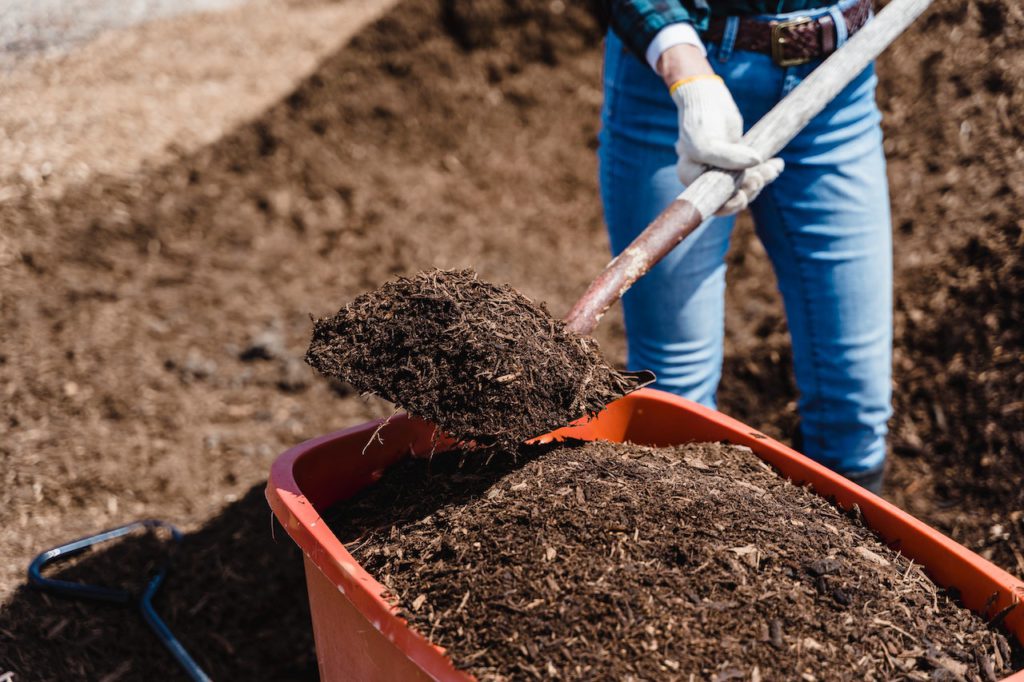The journey from soil preparation to bountiful harvests is a tale of science, art, and resourcefulness in gardening. One often overlooked chapter in this story is the role of organic amendments that enrich the soil and nurture plant growth. Among these, mushroom compost and screenings are unsung heroes, offering gardeners a natural and nutrient-rich solution to cultivating thriving gardens.
The Origins of Mushroom Compost
Mushroom compost, often called “mushroom soil,” results from a fascinating process that begins in mushroom cultivation facilities. As mushrooms grow, they are nurtured on a substrate of materials like straw, hay, and agricultural residues. As the mushrooms complete their growth cycle, the substrate becomes enriched with mycelium, the intricate network of fungal threads that support mushroom growth.
Once the mushrooms are harvested, the remaining substrate is collected and composted. Over time, this mixture decomposes and transforms into a nutrient-dense material that is an excellent soil amendment. Mushroom compost is rich in organic matter, minerals, and beneficial microorganisms, making it a valuable addition to garden beds and plant containers.
The Benefits of Mushroom Compost
The advantages of incorporating mushroom compost into gardening practices are manifold. First, mushroom compost enhances soil structure, improving drainage and water-holding capacity. This balance is essential for preventing waterlogged soils while ensuring plants receive adequate moisture during dry spells.
Furthermore, the organic matter in mushroom compost supports the development of a robust microbial community in the soil. Beneficial microorganisms contribute to nutrient cycling, breakdown of organic matter, and disease suppression. This microbial activity creates an environment conducive to plant growth and soil health.
In terms of nutrient content, mushroom compost is a treasure trove. It contains essential nutrients like nitrogen, phosphorus, and potassium, which are vital for plant development. These nutrients are released gradually as the compost breaks down, providing a steady supply that plants can access over time.
Screenings: Uncovering Nature’s Hidden Potential
In the gardening world, screenings – also known as “screened compost” or “screened composted mulch” – garner attention for their remarkable benefits. Screenings are created by passing compost through a fine mesh to remove larger particles, resulting in a fine-textured material that resembles dark, crumbly soil.
What sets screenings apart is their versatility. They can serve as a top dressing to improve soil structure, as a mulch to conserve moisture and suppress weeds, or as a growing medium for seedlings. The fine texture of screenings allows for excellent root penetration, making them an ideal substrate for plants at various stages of growth.
Screenings share many of the advantages of mushroom compost. They contribute to soil fertility by introducing organic matter and beneficial microorganisms. Moreover, screenings help maintain a balanced soil temperature, protecting plant roots from extreme heat and cold. This aspect is helpful for delicate seedlings and young plants.
Maximizing Garden Potential: Mushroom Compost and Screenings in Harmony

The synergy between mushroom compost and screenings is evident when these two organic amendments are combined in garden practices. Imagine a scenario where mushroom compost enriches the soil with nutrients and microbial life. At the same time, screenings offer a protective layer that conserves moisture, minimizes weed competition, and provides an ideal environment for plant roots to flourish.
When preparing garden beds or revitalizing existing ones, layering mushroom compost and screenings can yield exceptional results. The mushroom compost provides essential nutrients and sets the foundation for healthy plant growth. On top of this, screenings offer a finishing touch that optimizes the growing environment, helping plants establish themselves and thrive.
Application Tips for Success
Applying mushroom compost and screenings effectively requires some considerations. It’s essential to use compost well-mixedly to ensure an even distribution of nutrients. Depending on the specific needs of your plants, consider incorporating a layer of screenings after applying compost to provide added benefits.
When applying screenings as mulch, maintain a layer around 2-3 inches thick. This thickness offers the right balance of moisture retention, weed suppression, and insulation for plant roots. Over time, the screenings will break down and contribute to the organic matter content of the soil, enhancing its structure and fertility.
Sustainability and Environmental Benefits
Beyond their horticultural advantages, mushroom compost and screenings contribute to sustainable gardening practices. Mushroom compost repurposes agricultural byproducts that might otherwise go to waste, transforming them into a valuable resource that nourishes the soil and supports plant growth. This process aligns with the principles of circular economy and resource conservation, reducing the environmental impact associated with waste disposal.
Screenings, on the other hand, embody the concept of upcycling. Compost that has undergone the screening process gains new life as a fine-textured, versatile material with various applications. By using screenings as mulch, gardeners reduce the need for synthetic mulching materials, such as plastic, which can have negative ecological consequences. This shift towards using organic, locally produced materials is a step towards more environmentally responsible gardening practices.
Educational and Community Potential
Integrating mushroom compost and screenings into gardening practices presents an opportunity for education and community engagement. Gardening clubs, schools, and community organizations can organize workshops and demonstrations to showcase these organic amendments’ benefits and application techniques. By sharing knowledge about soil enrichment and sustainable gardening, these groups empower individuals to make informed choices that contribute to the well-being of both their gardens and the environment.
A Holistic Approach to Gardening
Integrating mushroom compost and screenings into gardening practices exemplifies a holistic approach to cultivation. Instead of relying solely on synthetic fertilizers and chemicals, gardeners embrace the interconnectedness of nature, drawing upon the transformative power of organic materials. This approach yields healthier plants and abundant harvests and contributes to the regeneration of soil health over time.
From fungi to fertilizer, the journey of mushroom compost and screenings is a story of innovation, resourcefulness, and sustainability. As gardeners, we are privileged to participate in this narrative, shaping our gardens and landscapes with organic wisdom.
